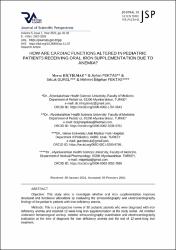How are cardiac functions altered in pediatric patients receiving oral iron supplementation due to anemia?
Citation
Hiçyılmaz, M. , Pektas, A. , Gürel, S. & Pektaş, M. B. (2021). HOW ARE CARDIAC FUNCTIONS ALTERED IN PEDIATRIC PATIENTS RECEIVING ORAL IRON SUPPLEMENTATION DUE TO ANEMIA? . Journal of Scientific Perspectives , 5 (1) , 81-92 . DOI: 10.26900/jsp.5.1.07Abstract
Objective: This study aims to investigate whether oral iron supplementation improves structural and functional alterations by evaluating the echocardiography and electrocardiography findings of the pediatric patients with iron deficiency anemia.Methods: This is a prospective review of 30 pediatric patients who were diagnosed with iron deficiency anemia and received 12-week-long iron supplementation at the study center. All children underwent hematological workup, detailed echocardiography examination and electrocardiography evaluation at the time of diagnosis for iron deficiency anemia andthe end of 12-week-long iron treatment.Results: After 12-week-long iron treatment, hemoglobin, mean corpuscular volume, mean corpuscular hemoglobin concentration, red blood cell count, Mentzer index, serum iron, serum iron binding capacity, serum ferritin and transferrin increased significantly (p=0.001, p=0.001, p=0.001, p=0.036, p=0.001, p=0.002, p=0.001 and p=0.001 respectively). Pulse rate, respiration rate, and diastolic left ventricle wall thickness decreased significantly while tricuspid E and A wave velocities increased significantly at the end of iron supplementation (p=0.004, p=0.033, p=0.009, p=0.003 and p=0.021 respectively). As for the tissue Doppler echocardiography findings, only interventricular septum isovolumetric contraction time decreased significantly after iron treatment (p=0.002). The PR interval shortened significantly, p dispersion decreased significantly and T-peak to T-end interval shortened significantly following iron supplementation (respectively p=0.013, p=0.033 and p=0.029).Conclusion: Oral iron supplementation seems to contribute to the reversal of cardiac remodeling, elimination of compensatory hemodynamic mechanisms and inhibition of sympathetic activation within cardiac tissues
Source
Health Sciences QuarterlyVolume
5Issue
1Collections
- Yayın Koleksiyonu [29]
















